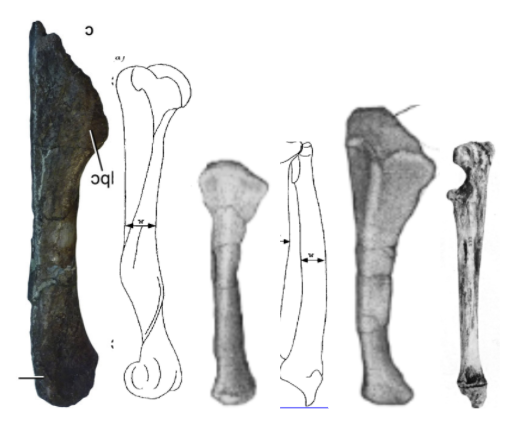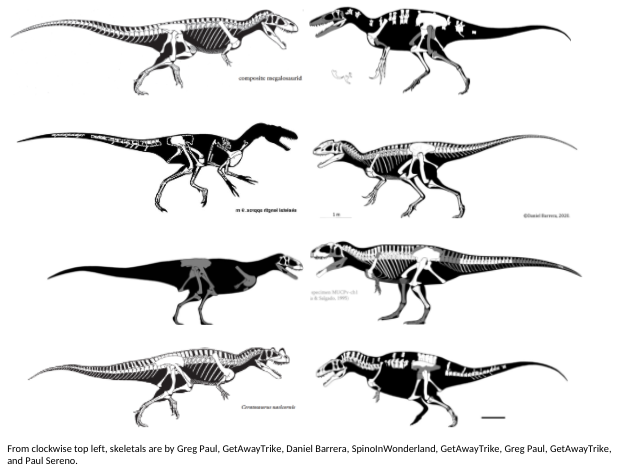HOME | DD
 TriceratopsHorridus — Megaraptor redux: part 2
TriceratopsHorridus — Megaraptor redux: part 2

#bear #brownbear #cretaceous #dinosaur #grizzlybear #megaraptor #theropod #tyrannosauroid #theropoddinosaur #megaraptoran
Published: 2021-06-14 23:36:37 +0000 UTC; Views: 1695; Favourites: 3; Downloads: 0
Redirect to original
Description
Part 1: www.deviantart.com/triceratops…As alluded to in Part 1 of this deviation series, Megaraptor seems to have very large and strong arms. But how large and strong exactly?
These are the preserved and estimated sizes of the forelimb bones in MUCPv-341 (left) compared to those of a semi-hypothetical 1000 kg brown bear of the same size. It's plainly visible which animal has larger and more robust forelimbs for its size, and it's not the bear.
For how this was reached, In Sorkin (2006) , a 680 kg Alaskan brown bear (FMNH 63802) has a 44.4 cm humerus, a 34.9 cm radius, and a 35.8 cm ulna. At hypothetical size parity with MUCPv-341 following Greg Paul's 1000 kg estimate (cubic root of (1000/680) times any of its arm bone lengths), it would have a 50.5 cm humerus, a 39.7 cm radius, and a 40.7 cm ulna, compared to (as stated in Part 1) an estimated 58 cm humerus, 36.9 cm radius, and 44.6 cm ulna in MUCPv-341.
Megaraptor clearly isn't at any disadvantage in terms of proportional forelimb size. Its humerus is 14.9% proportionally longer and its ulna is 9.6% proportionally longer, with both being visibly more robust* than the humerus and ulna of the bear. The only bone which isn't longer is the radius at a mere 7.6% proportionally shorter, and it does not appear to be any less robust than that of the bear, merely shorter.
*While I am not aware of any published measurements of radius and ulna circumference for either Megaraptor or the brown bear, I know of humerus circumference for both. Campione & Evans (2012) supplementary gives the circumference of a 40.1 cm grizzly bear humerus as 14.6 cm, so we can estimate the humerus circumference of this semi-hypothetical giant bear at 18.4 cm.
On the other hand, the humerus of Megaraptor was more robust than that, with its circumference being approximately 40% of its length. As page 2 of Novas et al. (2016) says:
Apart from the similarity with some coelurosaurs described for the distal end, the robust construction of the humerus in Megaraptor and Australovenator is closer to Allosaurus (width:length ratio approximately 40; Madsen, 1976; Hocknull et al., 2009; Porfiri et al., 2014) than the elongate and more gracile humeral proportions of Guanlong and Deinonychus (width:length ratio approximately 30; pers. obs.)
From that, we get an estimated 23.2 cm for the circumference of MUCPv-341's humerus. Assuming all the above is roughly accurate, Megaraptor seems to have had a humerus circumference 26.1% greater than that of a same sized brown bear, which is quite impressive (that's over a quarter more robust!). Note that the ulna was probably at a similar or greater proportional robusticity advantage, based on the comparison.
Long story short, considering the proportions of its own species, I see no justification whatsoever for Megaraptor to have arms as short/small as existing skeletals depict. Proportionally larger and more robust forelimbs than a brown bear is far more justifiable.
NOTE: I do not own the diagrams used here. The humerus/radius of the bear are from here and the ulna is from here , while the Megaraptor humerus is from Porfiri et al . (2014) and the radius/ulna are from Calvo et al. (2004).


























